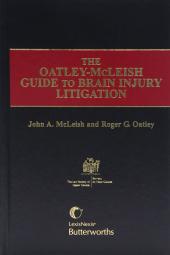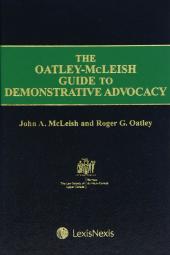The Oatley-McLeish Guide to Demonstrative Advocacy
One Year Subscription Only Terms
Subscribers receive the product(s) listed on the Order Form and any Updates made available during the annual subscription period. Shipping and handling fees are not included in the annual price.
Subscribers are advised of the number of Updates that were made to the particular publication the prior year. The number of Updates may vary due to developments in the law and other publishing issues, but subscribers may use this as a rough estimate of future shipments. Subscribers may call Customer Support at 800-833-9844 for additional information.
Subscribers may cancel this subscription by: calling Customer Support at 800-833-9844; emailing customer.support@lexisnexis.com; or returning the invoice marked 'CANCEL'.
If subscribers cancel within 30 days after the product is ordered or received and return the product at their expense, then they will receive a full credit of the price for the annual subscription.
If subscribers cancel between 31 and 60 days after the invoice date and return the product at their expense, then they will receive a 5/6th credit of the price for the annual subscription. No credit will be given for cancellations more than 60 days after the invoice date. To receive any credit, subscriber must return all product(s) shipped during the year at their expense within the applicable cancellation period listed above.
Product description
**Please note LexisNexis' USBs, CDs and DVDs are not compatible with Mac software.
Win More Trials Through the Effective Use of Demonstrative Evidence
Successful advocates have long known that their arguments in court are much more persuasive when accompanied by effective visuals. In this vividly-illustrated book, with each chapter written by renown personal injury experts, the reader will learn how to effectively use demonstrative evidence, at each stage of litigation, from opening statement to cross examination to closing statement.
Book Features:
- Contains an invaluable CD-ROM with animations that were actually used in courtroom trials. Instead of still-images or storyboards, the reader can actually view how the animations were used in court, and why and how they were developed
- Contains detailed illustrations and numerous examples of demonstrative evidence, as used in trials, mediation and arbitration
- Explains the theory and principles behind demonstrative evidence, as well as the practical applications of using demonstrative evidence
- Covers the use of demonstrative evidence for specific cases, from spinal cord injuries to brain injuries to orthopedic cases
Why Should Readers Buy This Book?
- An authoritative resource on the use, creation and application of demonstrative evidence, for beginner to seasoned advocates
- Easy-to-use guide where readers can choose chapters that apply specifically to their situation, whether it's the use of demonstrative evidence for assessing damages, or the use of demonstrative evidence in an opening or closing statement
- While other textbooks cover the topic of demonstrative evidence in a general manner, this guide focuses on the use of demonstrative evidence in personal injury cases
- Each contributor to this book are successful personal injury experts who offer their valuable insight, guidance and advice on how they've used demonstrative evidence in personal injury advocacy
Who Should Buy This Book?
- Plaintiff side personal injury lawyers - learn how you can use demonstrative evidence to persuade judges and juries on the strength of your case
- Defence side personal injury lawyers - learn how you can use demonstrative evidence to rebut plaintiff arguments against your client
- Insurance companies - learn how lawyers use demonstrative evidence to win or defend law suits, and to quantify damages
- Commercial litigators - while this book focuses on how demonstrative evidence is used in personal injury cases, many of the applications and principles can be readily applied to commercial litigation cases
Figures and motion-media examples created with the assistance of Stephen Mader and Artery Studios.
Table of contents
Part 1: The Foundation
1) Why Demonstrative Evidence? Why Is it So Effective? (John A. McLeish)
2) Demonstrative Evidence: The Law: Principles and Definitions (Troy H. Lehman)
Part 2: Helping the Jury See it Your Way
3) Do You See What I Mean? Fundamentals of Visual Learning and Communication (Drew R. Sinclair)
4) Visualizing Medicine: The Commissioning and Utilization of Customized Medical Illustration and Other Media for Personal Injury Proceedings (Stephen Mader)
5) The Use of Demonstrative Evidence for Damages (Rikin Morzaria)
6) Computer Animation: A Persuasive Tool (Robert M. Durante)
7) Getting the Most Out of Demonstrative Advocacy: Communication Strategies (John Plank)/The Language of Demonstrative Advocacy (Roger G. Oatley)
8) More Than Pretty Pictures: Creating Winning Trial Graphics (G. Christopher Ritter)
Part 3: Opening Statements
9) The Use of Demonstrative Aids in Opening Statements (Roger G. Oatley)
Part 4: Examination in Chief and Cross-Examination
10) Demonstrative Evidence: Use in Direct Examination (John A. McLeish)
11) The Use of Demonstrative Evidence in Cross-Examination (D. Keith Smockum)
Part 5: At Mediation
12) Demonstrative Evidence on Mediation (Paul G. Torrie and Susan E. Gunter)
Part 6: Specific Cases
13) The Use of Demonstrative Evidence in a Traumatic Brain Injury Case (John A. McLeish)
14) The Use of Demonstrative Evidence in Spinal Cord Injury Cases (Rikin Morzaria)
15) The Use of Demonstrative Evidence in Orthopaedic Cases (Alison Burrison)
Part 7: Closing
16) The Use of Demonstrative Evidence in Closing Statements (Roger G. Oatley)
Related products
-
 The LAT Handbook: Dispute Resolution Procedure for Accident BenefitsRelease date: August 16, 2016$100.00
The LAT Handbook: Dispute Resolution Procedure for Accident BenefitsRelease date: August 16, 2016$100.00 -
New!Preorder
 Addressing the Jury: Achieving Fair Verdicts in Personal Injury Cases, 3rd EditionNew!Release date: February 03, 2025$145.00
Addressing the Jury: Achieving Fair Verdicts in Personal Injury Cases, 3rd EditionNew!Release date: February 03, 2025$145.00 -
 The Oatley-McLeish Guide to Brain Injury LitigationRelease date: January 01, 2005$455.00
The Oatley-McLeish Guide to Brain Injury LitigationRelease date: January 01, 2005$455.00
 Lexis Nexis
Lexis Nexis 